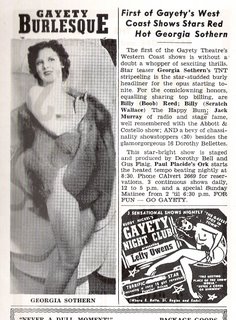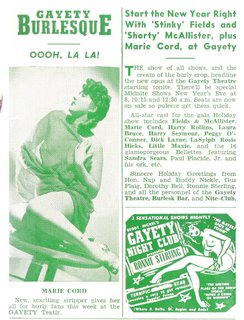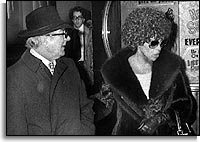
The lovely, luminous Lucia Bose
Just when you think you've seen all the cult and arthouse films you need to see and are free to numb your mind watching the The Gilmore Girls on the idiot box, Turner Classic Movies reels you right back in with some undiscovered gem. Like Juan Antonio Bardem's 1955 masterpiece The Death of a Cyclist. I accidentally started watching this film Tuesday night while flipping through the channels, noticed the beautiful actress Lucia Bose, and was instantly hooked. The neo-realistic style initially fooled me into thinking it was an Italian film, but while Lucia Bose is in fact a mote bellisimo Italian actress (and a former Miss Italy), I soon picked up from the dialogue that it was indeed Spanish (and officially known there as Muerte de un Ciclista; in 1958 it was released in America under the title Age of Infidelity).
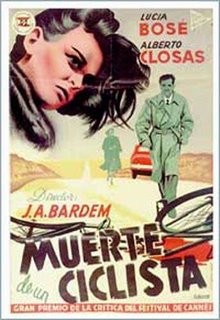 Apparently, TCM is celebrating the 50th anniversary of Janus films every Tuesday night in September and October. It's part of Janus' national promotion of its imminent "Essential Art House" DVD box set release coming in October (the 14-pound box set will contain 50 classic films on DVD and a 240-page illustrated hardcover book that tells the story of Janus Films through an essay by film historian Peter Cowie, a short tribute from Martin Scorsese, and extensive notes on all 50 films, plus cast and credit listings and U.S. premiere information). As part of the celebration, from September 30 through October 26, Lincoln Center and the New York Film Festival will present a tribute to Janus Films, featuring new or pristine 35mm prints of thirty-two of most of their classic titles, many of which have not been seen in years and are unavailable on DVD. That indoor "hardtop" series, like the one TCM is broadcasting, will include some of the most beloved works of Jean Renoir, Truffaut, Kurosawa, Jean Cocteau, Bergman, Agnès Varda, Fellini, Max Ophüls, and many more.
Apparently, TCM is celebrating the 50th anniversary of Janus films every Tuesday night in September and October. It's part of Janus' national promotion of its imminent "Essential Art House" DVD box set release coming in October (the 14-pound box set will contain 50 classic films on DVD and a 240-page illustrated hardcover book that tells the story of Janus Films through an essay by film historian Peter Cowie, a short tribute from Martin Scorsese, and extensive notes on all 50 films, plus cast and credit listings and U.S. premiere information). As part of the celebration, from September 30 through October 26, Lincoln Center and the New York Film Festival will present a tribute to Janus Films, featuring new or pristine 35mm prints of thirty-two of most of their classic titles, many of which have not been seen in years and are unavailable on DVD. That indoor "hardtop" series, like the one TCM is broadcasting, will include some of the most beloved works of Jean Renoir, Truffaut, Kurosawa, Jean Cocteau, Bergman, Agnès Varda, Fellini, Max Ophüls, and many more. After watching the Bardem gem, I watched a film Bardem helped make possible, Luis Bunuel's Viridiana, followed by Jean Cocteau's Beauty and the Beast (1946) and Cocteau's masterpiece, Orpheus (1949).
After watching the Bardem gem, I watched a film Bardem helped make possible, Luis Bunuel's Viridiana, followed by Jean Cocteau's Beauty and the Beast (1946) and Cocteau's masterpiece, Orpheus (1949).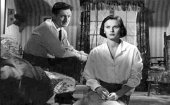 I'm bleary-eyed as a result, so I'll leave to others to describe Death of a Cyclist and director Bardem in detail (Marsha Kinder's study of Spanish cinema, Blood Cinema, is a good place to start). Suffice it to say that it's a beautifully-acted psychological drama whose guilt-ridden and class-conscious narrative is equal parts Macbeth and I Know What You Did Last Summer and is noteworthy for its brilliant editing technique. One minute you're watching bored aristocrats dance at a society ball, the next street urchins are kicking a ball in a run-down barrio - all courtesy of a seamless panning shot. And the print is gorgeous! Needless to say, I'm vexed that I didn't tape Death of a Cyclist, because it's currently not available on video or DVD. Doh!
I'm bleary-eyed as a result, so I'll leave to others to describe Death of a Cyclist and director Bardem in detail (Marsha Kinder's study of Spanish cinema, Blood Cinema, is a good place to start). Suffice it to say that it's a beautifully-acted psychological drama whose guilt-ridden and class-conscious narrative is equal parts Macbeth and I Know What You Did Last Summer and is noteworthy for its brilliant editing technique. One minute you're watching bored aristocrats dance at a society ball, the next street urchins are kicking a ball in a run-down barrio - all courtesy of a seamless panning shot. And the print is gorgeous! Needless to say, I'm vexed that I didn't tape Death of a Cyclist, because it's currently not available on video or DVD. Doh!
Accidents will happen; they're always hit & run
TCM'S DEATH OF A CYCLIST REVIEW
In Spanish director Juan Antonio Bardem's lacerating Death of a Cyclist (1955), released in America as Age of Infidelity, a couple traveling through the countryside strike a man on a bicycle. When they get out of their car to examine him, they find that he is injured but not dead. But instead of helping the man, Juan (Alberto Closas) and Maria Jose (Lucia Bosé) do the unthinkable. They flee - rather than reveal that they have been carrying on a long-term affair.
When they return to Madrid, the couple pay a terrible price for their deception. Guilt begins to gnaw away at them, especially at Juan, who is also experiencing conflict with his young students over an ethical issue at the university where he teaches.
Maria Jose is less bothered by the moral implications of killing a man, as she is fearful that her affair will be discovered and her social position slip should her wealthy industrialist husband Miguel (Otello Toso) find out. Matters become even more complicated when the couple discover a member of their social circle, a hanger-on and art critic, Rafa (Carlos Casaravilla), may know something about their affair and the crime and intends to trade on what he knows for money.
Maintaining an intense level of suspense, director Juan Antonio Bardem examines not only the burden of guilt, but also a Spanish society of disturbing schisms where people like Juan and Maria Jose operate above the law, in a bubble of wealth and privilege, while far below people like the dead cyclist's family and neighbors struggle to survive. These themes are further articulated in a haunting musical score by Isidro B. Maiztegui.
Unlike the dominant cinema of the day, Bardem veered away from the militarist, costume dramas and literary adaptations preferred during Francisco Franco's dictatorship. Highly influenced in tone and style by Italian neorealism, Bardem helped bring Spanish cinema to international prominence with his socially conscious and stylish films.
Bardem, who initially trained as an agricultural engineer, would go on to direct a number of other films which often concentrated on a central character named Juan and his disgust with the suffocating society in which he lived.
Death of a Cyclist was hailed by the international film community and became a winner of the International Critics Award at the 1955 Cannes Film Festival. At least one American critic was unable to appreciate Bardem's gift. In an ungenerous and shortsighted review in The New York Times, Bosley Crowther criticized Bardem's unique style in which the lovers are perpetually linked through editing, a self-consciously artful device which Crowther misunderstood as a technical deficiency.
At the time of his Cannes award, Bardem was serving a prison sentence for his political beliefs, until international outcry eventually led to his release from prison. Nevertheless, Bardem was arrested a total of seven times under Franco.
Spanish cinema under Franco was a stifled and sterile industry, kept under strict government control. Bardem was one of the few brave filmmakers to question the psychological and political oppression of the day and deal with the realities of contemporary life. As Bardem wrote in a 1955 manifesto of film principles being adopted by the Spanish filmmaking vanguard, "Spanish cinema has turned its back on reality and is totally removed from Spanish realistic traditions as found in paintings and novels."
Biting social criticism was the foundation of Bardem's work beginning with his first film, That Happy Couple (1953) co-directed by frequent collaborator Luis Garcia Berlanga, ironically enough, about a chronically unhappy couple.
In 1953, Bardem founded a Spanish film journal Objectivo which would become the voice of the country's cinemaphiles before it was banned, just two years later, by the Franco government.
Bardem continued his critique with his most acclaimed film, Death of a Cyclist. Though scathing for showing the stark, cruel divisions between rich and poor in contemporary Madrid, the film also offered some concessions to Franco moralism. At the film's end, Maria Jose must be punished for her role in the affair and tragic accident, much in the way the wayward women in Hollywood melodramas were invariably punished for their transgressions. Bardem's films were also frequently censored and reedited to bring them more in line with Franco-era politics.
In 1958 Bardem, acting as president, founded the independent production company UNINCI. Under his leadership, Luis Buñuel was invited back to Spain from exile to make Viridiana (1961). But Buñuel's film was banned and UNINCI was closed down for co-producing the film. Though he continued to make films, often international co-productions in Italy and France and works in Spain such as The Mysterious Island of Captain Nemo (1973) starring Omar Sharif, Bardem suffered for the remainder of his career under Franco's restrictions. Unfortunately, his death in 2002 meant that Bardem did not live long enough to see the cultural freedoms that came about after Franco's death.
Director: Juan Antonio Bardem
Producer: Georges de Beauregard, Manuel J. Goyanes
Screenplay: Juan Antonio Bardem from a short story by Luis F. Delgoa
Cinematography: Alfredo Fraile
Production Design: Enrique Alarcón
Music: Isidro B. Maiztegui
Cast: Lucia Bosé (Maria Jose), Alberto Closas (Juan), Otello Toso (Miguel), Carlos Casaravilla (Rafa).
BW-88m.
- by Felicia Feaster
BARDEM OBIT

Juan Antonio Bardem (pictured above) died in 2002. Below is a reposting of Ronald Bergen's obit from The Guardian.
JUAN ANTONIO BARDEMLUCIA BOSE BIO
Brave director whose films mocked the repession of Franco's Spain
Ronald Bergan
Saturday November 2, 2002
The Guardian
After the Spanish civil war, the victorious nationalists immediately began to bring the film industry under government control; as a result, its output in the 1940s reflected the sterility of the country's moral and political repression. But in the 1950s, a new generation of Spanish directors emerged, headed by Juan Antonio Bardem, who has died aged 80, and Louis Garcia Berlanga.
As far as it was possible, both men rejected the values of the Franco regime, and the militaristic, folkloric costume films it sanctioned. With their first co-directed feature, That Happy Couple (1951), it was clear that they had chosen to go against the prevailing trend by presenting scenes of contemporary Spanish life, and using humour to describe and criticise aspects of society.
Bardem, whose parents were actors, originally trained as an agricultural engineer, and was assigned to the agriculture ministry's cinema section in 1946. The following year, he became a student at the Spanish institute of cinema research and experimentation, but failed to get a diploma, possibly because of his political views. Thereafter, he supported himself by writing articles and criticism, and directing short documentaries.
The turning point came with That Happy Couple, much influenced by Italian neo-realism, a style which was already passé in Italy. The title is ironic, since the young couple, offered Madrid at their feet for a day by a soap company, are not really happy.
It was followed by Welcome, Mr Marshall (1952), one of the biggest international successes of the Franco years, which Bardem co-wrote with Berlanga, who directed. Another example of Spanish neo-realism, it focuses on a poor village in Castile trying to create a good impression on visiting Americans in the hope of getting Marshall aid. Pointedly written and observed, the film was condemned by Edward G Robinson, a member of the Cannes festival jury, as anti-American. However, it is far more a sardonic look at Spanish foibles and greed.
In 1953, Bardem founded Objectivo, a cinema journal that became a rallying point for cinéastes, raised the level of film criticism in Spain and informed readers about prohibited films. Two years later, it was banned by the government after only nine issues.
Bardem made his most celebrated solo effort in 1955, writing and directing Death Of A Cyclist. An attempt to make a socially critical film under Franco, it tells the story of a university professor and his well-connected mistress who knock down a worker on a bicycle while out driving. Fearful that their affair will be discovered, they leave the man to die. The contrasting milieu of the rich and poor districts of Madrid are well caught, but censorship forced Bardem to punish the adulterous woman in a melodramatic ending.
At a meeting in Salamanca in 1955, a statement of principles was penned in which Bardem wrote: "After 60 years, Spanish cinema is politically futile, socially false, intellectually worthless, aesthetically valueless, and industrially paralytic. Spanish cinema has turned its back on reality and is totally removed from Spanish realistic traditions as found in paintings and novels."
But the situation worsened, and Bardem was imprisoned on political grounds while shooting the uncomfortable comedy-drama Calle Mayor (1956). He was in jail when Death Of A Cyclist won the Cannes critics' prize, but was released after two weeks following an international outcry, and was able to complete his new film - though he was arrested several more times during the Franco years.
Calle Mayor involved a group of provincial layabouts who, for a bet, persuade a young stud from Madrid to make love and propose to a plain spinster, Betsy Blair, virtually repeating her Oscar-nominated role in Marty, the year before. The atmosphere of a stultifying small town is well caught, as is the portrayal of machismo, but, again, Bardem was under some restraint.
His next film, The Reapers, was intended as a critical study of peasant life, but was heavily censored and re-edited. As a conventional melodrama, and retitled Vengeance, it was coolly received in Cannes in 1958.
That same year, in desperation, Bardem, Berlanga, Carlos Saura and other directors founded their own production company, UNINCI. It was Bardem, as president, who bravely invited Luis Bunuel back to Spain after a 29-year exile to make Viridiana (1961), but, although the script of this savage comedy on Catholic mentality and rituals was unaccountably passed by Franco's censors, it was banned outright in Spain, and UNINCI was closed down.
These battles sapped Bardem's creative energy, though he continued to direct films in Spain, as well as co-productions in Italy, France and Argentina, many of which were shown at festivals around the world. In several works, he concentrated on a single character, often called Juan, who feels frustrated and stifled in a closed society.
Among his large, less personal, productions were The Uninhibited (Los Pianos Mecanicos, 1965), starring Melina Mercouri and James Mason, and The Mysterious Island Of Captain Nemo (1973), with Omar Sharif in the title role - both shot in Spain. His last film was Resultado Final, before which came two rather academic studies: Lorca, The Death Of A Poet (1987) and Young Picasso (1993), for television.
Sadly, the cultural liberation that followed Franco's death came too late for Bardem. He is survived by his wife Maria and their four children.
Juan Antonio Bardem, film director, born July 2 1922; died October 30 2002

Not much information is available in English about Lucia Bose - born Lucia Borlani January 28, 1931, who these days sports blue hair (as shown below),

but it is interesting to note that when the beautiful Milan native was crowned Miss Italy 1947, she stood on the same stage with a number of future Italian cinema stars, including Gina Lollobrigida, Silvana Mangano, Eleonora Rossi Drago and Gianna Maria Canale (as shown below). Quite a vintage crop, 1947!
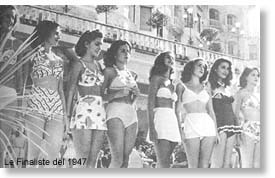
Miss Italy 1947 Finalists
Her first film, at age 19, was 1950's Non C'e Pace Tra Gli Ulive (Under the Olive Tree), followed by a starring role the same year in Michelangelo Antonioni's first feature, Cronica di un Amore (Story of a Love Affair). The plot of Cronica di un Amore is quite similar to Death of a Cyclist - in both cases Bose plays a commoner-turned-bourgois adulteress wife of a wealthy industrialist who carries the torch for a pre-war sweetheart (The Spanish Civil War in Bardem's film, World War II in Antonioni's) and who is suspected of murder in what Marsha Kinder (Blood Cinema) calls a "a class-crossed melodrama." (Antonioni had originally wanted American actress Gene Tierney to play the role of Bose's character Paola in Cronica di un Amore, perhaps impressed by Tierney's glamourous femme fatale role in 1945's Leave Her To Heaven.)
Bose was married to Luis Miguel Dominguin from 1955-1967, curtailing her film career between 1956-1966 to raise her family, which includes Miguel Bose and Paola Dominguin. Other notable films in her later career include roles in Fellini's Satyricon (1969), Jean Moreau's directorial debut Lumiere (1976) and 1999's Harum Suare. She also had an uncredited role in 1960 in Jean Cocteau's Testament d'Orphee (Testament of Orpheus). She most recently appeared in the Spanish TV series Las Cerezas (2005). A brief interview with a middle-aged, blue-haired Lucia Bose appears in "Story of a Peculiar Night," on the special features disc of the 2005 DVD release of Story of a Love Affair; the occasion was the screening of a restored print of Antonioni's film in Rome.

Related Links:
Essential Art House: 50 Years of Janus Films DVD
Juan Antonio Bardem bio (IMDB)
Death of a Cyclist (IMDB)
Lucia Bose Filmography (IMDB)
Blood Cinema: The Reconstruction of National Identity in Spain by Marsha Kinder (contains a chapter on Muerte de un Ciclista)
Death of a Cyclist review (roughly translated from Spanish site Cinefania.com)
Ozus' World Movie Reviews (by Dennis Schwartz)





